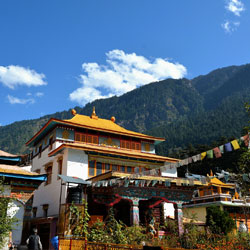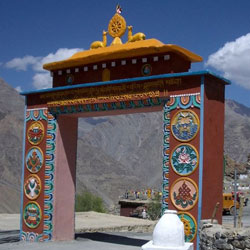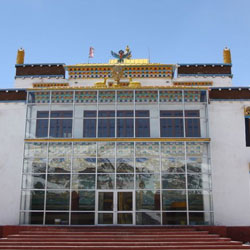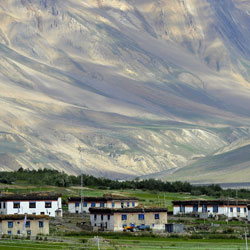
- Home
- Travel Packages
- Top Destination
-
Travel Attraction
By Category
Top Attraction

- Travel Agents
- Car Rentals
- Hotels

About Namgyal Monastery History, Architecture, and Design Namgyal Monastery is the personal monastery of the 14th Dalai Lama and is located in the town of Dharamshala in Himachal Pradesh, India. Founded in 1575 by the 3rd Dalai Lama, Sonam Gyatso, the monastery has a rich history and serves as one of the most important Tibetan monasteries outside of Tibet. The architecture of Namgyal Monastery is a blend of Tibetan and Indian styles, with colorful prayer flags fluttering in the wind and intricately carved wooden doors. The design of the monastery reflects the spiritual beliefs and practices of Tibetan Buddhism. Best Time to Visit The best time to visit Namgyal Monastery in Dharamshala is during the spring and autumn months, from March to May and September to November. The weather during these months is pleasant, with clear skies and comfortable temperatures, making it ideal for exploring the monastery and taking part in any cultural events or religious ceremonies that may be taking place. Cultural Significance Namgyal Monastery holds great cultural significance for Tibetan Buddhists and serves as a center for religious teachings, meditation practices, and rituals. The monastery is a focal point for the preservation and promotion of Tibetan culture and traditions in exile, as well as a place of refuge for those seeking spiritual guidance and enlightenment. Pilgrimage Practices Pilgrims from all over the world travel to Namgyal Monastery in Dharamshala to pay their respects to the Dalai Lama and to participate in religious ceremonies and teachings. Pilgrimage practices at the monastery may include offering prayers, lighting butter lamps, and receiving blessings from monks. Visitors are encouraged to observe proper etiquette and respect the traditions of the monastery during their pilgrimage. Dress Code and Etiquette Visitors to Namgyal Monastery are expected to dress modestly and respectfully, covering their shoulders and knees while on monastery grounds. It is also important to remove shoes before entering any prayer halls or temples and to refrain from taking photographs without permission. Visitors should also be mindful of their behavior and show respect for the monks and other practitioners at the monastery. Activities and Experiences Visitors to Namgyal Monastery can participate in a variety of activities and experiences, including attending meditation sessions, listening to teachings from resident monks, and taking part in traditional Tibetan rituals and ceremonies. The monastery also offers classes in Tibetan language, art, and philosophy for those interested in learning more about Tibetan culture and Buddhism. Art and Religious Symbols The walls of Namgyal Monastery are adorned with colorful thangka paintings, intricate wooden carvings, and sacred religious symbols such as the wheel of dharma and the lotus flower. These art forms serve as visual representations of Buddhist teachings and help to create a peaceful and meditative atmosphere within the monastery. Local Insights Local residents of Dharamshala and the surrounding area hold Namgyal Monastery in high esteem as a place of spiritual refuge and community gathering. The monastery plays an important role in the daily lives of locals, who often visit to offer prayers, receive blessings, and seek guidance from the resident monks. Visitors to the area can gain valuable insights into Tibetan culture and traditions by interacting with local residents and participating in events at the monastery.
Explore More
About Tibetan Monasteries Tibetan monasteries are spiritual centers preserving Buddhist traditions, culture, and teachings. Known for their serene ambiance, vibrant murals, and intricate architecture, they serve as meditation hubs for monks and visitors. Famous monasteries include Namgyal, Tawang, and Hemis, offering insights into Tibetan Buddhism, rituals, and monastic life. Tibetan Monasteries in Manali are not only religious centers but also serve as cultural hubs for the Tibetan community in the area. These monasteries are known for their stunning architecture, vibrant prayer flags, and peaceful surroundings. Architectural Facts The Tibetan Monasteries in Manali are characterized by intricate wood carvings, colorful murals, and traditional Tibetan architecture. The buildings typically feature ornate pagodas, prayer wheels, and Buddhist symbols, creating a serene atmosphere for visitors to explore and reflect. History The Tibetan Monasteries in Manali were established to preserve and promote Tibetan culture and Buddhism in exile. These monasteries serve as important religious and educational institutions for the Tibetan community, offering teachings, rituals, and ceremonies to local and visiting practitioners. Location The Tibetan Monasteries are located in various parts of Manali, with the most famous ones including the Gadhan Thekchhokling Gompa, Himalayan Nyingmapa Gompa, and the famous monastery in the nearby town of Rewalsar. Visiting Hours The monasteries are usually open to visitors from early morning till evening. It is recommended to check the specific visiting hours of each monastery before planning your visit. Gurudwara Services and Events The Tibetan Monasteries in Manali often host special events, ceremonies, and festivals throughout the year. Visitors can experience traditional Tibetan rituals, prayers, and cultural performances during these events. The monasteries may also offer guided tours and meditation sessions for interested visitors. Accessibility and Directions Visitors can reach the Tibetan Monasteries in Manali by car or public transport. The monasteries are easily accessible from the main town and are well signposted. Parking facilities are available near most monasteries, and some may offer wheelchair accessibility for those with mobility challenges. Visitor’s Information There is usually no entry fee to visit the Tibetan Monasteries in Manali, but donations are welcome to support the upkeep of the monasteries. Visitors are advised to dress modestly and remove shoes before entering the prayer halls. Guides may be available to provide information about the history and traditions of the monasteries. Nearby attractions to visit around the monasteries include scenic viewpoints, hiking trails, and local markets. Best Time to Visit The best time to visit the Tibetan Monasteries in Manali is during the spring and autumn months when the weather is pleasant and many festivals and events take place. The monasteries are also popular destinations for weekend getaways and spiritual retreats.
Explore More
About The Manali Gompa History The Manali Gompa, also known as the Gadhan Thekchhokling Gompa, is a Buddhist monastery located in the town of Manali in the Indian state of Himachal Pradesh. The monastery was built in the 1960s by Tibetan refugees who settled in the region. It is a peaceful sanctuary that serves as a place of worship, meditation, and learning for the local Buddhist community and visitors alike. Architecture and Design The Manali Gompa features traditional Tibetan architecture with a pagoda-style structure adorned with intricate paintings, colorful prayer flags, and prayer wheels. The monastery is surrounded by lush greenery and offers panoramic views of the surrounding mountains, creating a serene and tranquil atmosphere for visitors to explore and experience. Best Time to Visit The best time to visit the Manali Gompa is during the months of May to June and September to October when the weather is pleasant and the surrounding landscape is lush and vibrant. Avoid visiting during the winter months as the region experiences heavy snowfall, making travel difficult. Cultural Significance The Manali Gompa is an important cultural and religious site for the Tibetan Buddhist community in the region. It serves as a center for religious ceremonies, teachings, and cultural events, preserving the rich heritage and traditions of Tibetan Buddhism for future generations to experience and learn from. Pilgrimage Practices Visitors to the Manali Gompa can participate in traditional Buddhist practices such as meditation, chanting, and offering prayers. Pilgrims often circumambulate the monastery while spinning prayer wheels and offering butter lamps as a form of devotion and spiritual practice. Dress Code and Etiquette Visitors to the Manali Gompa are expected to dress modestly and respectfully, covering their shoulders and legs out of respect for the sacredness of the site. It is also important to maintain a quiet and peaceful demeanor while inside the monastery, refraining from loud conversations or disruptive behavior. Activities and Experiences Visitors to the Manali Gompa can participate in a variety of activities and experiences, including attending religious ceremonies, receiving blessings from the resident monks, exploring the monastery's grounds and surrounding gardens, and learning about the history and teachings of Tibetan Buddhism through guided tours and cultural programs. Art and Religious Symbols The Manali Gompa is adorned with stunning artwork and religious symbols that tell the stories and teachings of Tibetan Buddhism. Visitors can admire the intricate murals, statues, and thangka paintings that decorate the walls and interiors of the monastery, each carrying deep spiritual and cultural significance. Local Insights Local residents and monks at the Manali Gompa are happy to share their knowledge and insights into Tibetan Buddhism and the history of the monastery with visitors. By engaging with the community and participating in cultural events and ceremonies, visitors can gain a deeper understanding and appreciation for the traditions and practices of Tibetan Buddhism.
Explore More
About Lhalung Monastery, Lahaul & Spiti History: Lhalung Monastery, also known as the Golden Temple, is one of the oldest monasteries in Lahaul & Spiti district of Himachal Pradesh, India. It was founded in the 10th century by Rinchen Zangpo, a famous Tibetan translator who was responsible for building several monasteries in the region. Architecture and Design: The monastery is built in traditional Tibetan architectural style, with whitewashed walls and colorful prayer flags adorning the exterior. The main prayer hall houses a statue of Lord Buddha and intricate wall paintings depicting Buddhist scriptures and deities. Best Time to Visit Cultural Significance: Lhalung Monastery holds great cultural significance for the local community, as it serves as a spiritual and educational center for Buddhist monks and nuns. It also plays an important role in preserving the rich cultural heritage of the region. Pilgrimage Practices: Many pilgrims visit Lhalung Monastery throughout the year to pay their respects to the Buddha and seek blessings from the resident monks. Pilgrims often participate in prayer ceremonies and rituals during their visit. Dress Code and Etiquette: Visitors to Lhalung Monastery are expected to dress modestly and respectfully, covering their shoulders and knees. It is important to remove shoes before entering the prayer halls and to maintain a quiet and peaceful demeanor while on the monastery grounds. Activities and Experiences Art and Religious Symbols: The monastery is adorned with colorful murals, thangka paintings, and intricately carved pillars that showcase the artistic and religious traditions of Tibetan Buddhism. Visitors can immerse themselves in the beauty and symbolism of these sacred artworks. Local Insights: Visitors to Lhalung Monastery have the opportunity to interact with local monks and nuns, gaining insights into their daily lives, spiritual practices, and cultural traditions. This firsthand experience allows for a deeper appreciation of the monastery and its significance in the community. Overall, Lhalung Monastery offers a unique and enriching cultural experience for visitors seeking to explore the spiritual and artistic heritage of Lahaul & Spiti.
Explore More
About Kungri Monastery History Kungri Monastery, located in the picturesque region of Lahaul & Spiti in Himachal Pradesh, has a rich history dating back several centuries. It was founded by Lama Norbu Dorje in the 14th century and has since been a spiritual hub for the local community. Architecture and Design The monastery is known for its traditional Tibetan architecture, with intricate carvings, vibrant murals, and prayer wheels adorning its walls. The main prayer hall is adorned with colorful thangkas and statues of Buddhist deities, creating a serene and sacred atmosphere. Best Time to Visit Cultural Significance Kungri Monastery holds immense cultural significance for the people of Lahaul & Spiti, serving as a center for religious ceremonies, teachings, and festivals. It is a place where locals come to seek blessings, meditate, and connect with their spiritual roots. Pilgrimage Practices Pilgrims visit Kungri Monastery throughout the year, but the most popular time is during the annual festival of Tsechu, where monks perform sacred rituals, dances, and prayers to commemorate the teachings of Buddha. Dress Code and Etiquette Visitors to Kungri Monastery are expected to dress modestly and respectfully, covering their shoulders and knees. It is important to maintain a quiet and reverent demeanor while inside the monastery, as it is a place of worship and meditation. Activities and Experiences Art and Religious Symbols The monastery is adorned with exquisite artwork, including intricate mandalas, thangkas, and statues that depict the rich religious symbolism of Tibetan Buddhism. Visitors can immerse themselves in the beauty and symbolism of these sacred artworks. Local Insights Exploring Kungri Monastery offers a unique opportunity to gain insight into the local culture and way of life in Lahaul & Spiti. Visitors can interact with monks, participate in prayers and rituals, and learn about the traditions and beliefs that have been passed down through generations.
Explore More
About Tabo Caves, Lahaul & Spiti The Tabo Caves in Lahaul & Spiti are a fascinating archaeological site, known for their historical significance and unique architecture and design. These caves have been used by monks and spiritual seekers for meditation and retreat for centuries. History The Tabo Caves have a rich history dating back to over a thousand years. They were originally used as a place of meditation and worship by Buddhist monks. The caves also served as a refuge for those seeking spiritual enlightenment. Architecture and Design The caves are carved into the cliffs of the Himalayas and feature intricate designs and murals depicting Buddhist teachings and symbols. The architecture reflects the ancient Buddhist traditions and the spiritual significance of the site. Best Time to Visit The best time to visit the Tabo Caves in Lahaul & Spiti is during the summer months, from May to September. This is when the weather is pleasant, and the caves are accessible for exploration. The winter months can be harsh and snowy, making it difficult to visit the site. Cultural Significance The Tabo Caves hold great cultural significance for the people of Lahaul & Spiti and Buddhists around the world. They are considered sacred and are a place of pilgrimage for many believers. The caves are also a reflection of the region's rich Buddhist heritage. Pilgrimage Practices Visitors to the Tabo Caves are encouraged to engage in respectful and mindful practices during their visit. Pilgrims often participate in meditation and prayer at the site, seeking spiritual growth and enlightenment. It is important to follow local customs and traditions while visiting the caves. Dress Code and Etiquette It is important to dress modestly and respectfully when visiting the Tabo Caves. Visitors should cover their shoulders and knees and avoid wearing revealing clothing. It is also important to maintain a quiet and reverent demeanor while exploring the caves, out of respect for the spiritual significance of the site. Activities and Experiences Visitors to the Tabo Caves can partake in a variety of activities and experiences, including guided tours, meditation sessions, and cultural performances. Exploring the intricate murals and designs within the caves can offer a profound spiritual experience. Visitors can also enjoy the scenic beauty of the surrounding Himalayan mountains. Art and Religious Symbols The Tabo Caves are adorned with beautiful murals and art depicting Buddhist teachings and religious symbols. The intricate designs and vibrant colors convey the spiritual significance of the site and offer visitors a glimpse into the ancient traditions of Buddhism. These artistic representations serve as a visual reminder of the teachings and philosophies of the faith. Local Insights Local residents of Lahaul & Spiti can provide valuable insights into the history and significance of the Tabo Caves. They can offer guidance on the best times to visit, local customs and traditions, and the spiritual practices associated with the site. Engaging with the local community can enhance the overall experience of exploring the caves and deepen one's understanding of the region's cultural heritage.
Explore More
About Losar, Lahaul & Spiti History, Architecture, and Design Losar, Lahaul & Spiti is a region located in the Indian state of Himachal Pradesh. It is known for its rich history and unique architecture influenced by Tibetan and Indian cultures. The traditional houses in the area are built using stone and wood, with colorful prayer flags adorning the rooftops. The monasteries in Losar, Lahaul & Spiti are architectural marvels, showcasing intricate designs and vibrant murals depicting Buddhist teachings. Best Time to Visit The best time to visit Losar, Lahaul & Spiti is during the summer months, from June to September. The weather during this time is pleasant, with clear skies and mild temperatures, making it ideal for exploring the region's stunning landscapes and cultural sites. Cultural Significance Losar, Lahaul & Spiti is steeped in cultural significance, with Buddhism being a major influence on the local traditions and way of life. The region is home to several ancient monasteries, where rituals and ceremonies are performed to honor the teachings of Buddha. Festivals such as Losar, the Tibetan New Year, are celebrated with great fervor, showcasing the vibrant cultural heritage of the region. Pilgrimage Practices Pilgrimage practices are an integral part of the spiritual life in Losar, Lahaul & Spiti. Many devotees embark on journeys to sacred sites and monasteries to seek blessings and enlightenment. Pilgrims often perform rituals such as circumambulating stupas and offering prayers, as a way to deepen their connection to the divine. Dress Code and Etiquette When visiting Losar, Lahaul & Spiti, it is important to dress modestly and respectfully, especially when entering monasteries and religious sites. Visitors are advised to wear conservative clothing that covers their shoulders and knees, as a sign of respect for the local customs and traditions. It is also customary to remove shoes before entering temples and monasteries. Activities and Experiences Visitors to Losar, Lahaul & Spiti can enjoy a variety of activities and experiences, ranging from trekking in the pristine mountains to attending traditional Buddhist ceremonies. Other popular activities include visiting the ancient monasteries, exploring local markets, and participating in cultural festivals. The region also offers opportunities for meditation and spiritual retreats, allowing visitors to connect with their inner selves in a tranquil environment. Art and Religious Symbols Art and religious symbols play a significant role in the culture of Losar, Lahaul & Spiti. The region is known for its intricate thangka paintings, vibrant murals, and intricately carved statues depicting Buddhist deities and symbols. These artistic expressions serve as a form of meditation and devotion, conveying spiritual teachings and inspiring a sense of awe and reverence among the faithful. Local Insights Local insights into the customs and traditions of Losar, Lahaul & Spiti can offer visitors a deeper understanding of the rich cultural heritage of the region. Through interactions with the local community, visitors can learn about the daily life, beliefs, and practices of the people living in this remote corner of the Himalayas. Engaging with locals in conversations, sharing meals, and participating in traditional activities can provide a unique and authentic cultural experience.
Explore More
About Sangla Monastery History The Sangla Monastery, also known as the Buddhist Monastery, is a historic and spiritual site located in the picturesque Sangla Valley in Himachal Pradesh, India. It was founded centuries ago by Buddhist monks who sought a peaceful retreat in the Himalayas. The monastery has since been a center of learning, meditation, and religious practice, attracting pilgrims and visitors from far and wide. Architecture and Design The Sangla Monastery is a magnificent example of traditional Tibetan Buddhist architecture, with its white-washed walls, colorful prayer flags, and ornate wood carvings. The main prayer hall is adorned with beautiful thangka paintings and statues of Buddha and other deities. The monastery complex also includes living quarters for monks, meditation halls, and a library with ancient manuscripts. Best Time to Visit Cultural Significance The Sangla Monastery holds great cultural and spiritual significance for the local community and for Buddhists around the world. It is a place of worship, meditation, and learning, where visitors can experience the ancient teachings and rituals of Tibetan Buddhism. The monastery also hosts various festivals and ceremonies throughout the year, offering a glimpse into the rich cultural heritage of the region. Pilgrimage Practices Many pilgrims visit the Sangla Monastery to seek blessings, offer prayers, and participate in religious rituals. Pilgrims often perform prostrations, circumambulate the monastery, and make offerings such as butter lamps and incense. These practices are believed to purify the mind, accumulate merit, and deepen one's spiritual connection to the Buddha and other enlightened beings. Dress Code and Etiquette Activities and Experiences Visitors to the Sangla Monastery can take part in a variety of activities and experiences, such as attending meditation sessions, joining in prayers and rituals, and learning about Buddhist philosophy and teachings. The monks at the monastery are often happy to chat with visitors and offer insights into their way of life and spiritual practice. The serene surroundings of the monastery also provide an ideal setting for contemplation and self-reflection. Art and Religious Symbols The Sangla Monastery is adorned with exquisite art and religious symbols that reflect the depth and beauty of Tibetan Buddhist culture. Intricate thangka paintings depicting scenes from the Buddha's life and teachings can be found throughout the monastery, along with statues of enlightened beings, mandalas, and other sacred objects. These symbols are believed to inspire devotion, insight, and spiritual transformation in those who encounter them. Local Insights Local residents of the Sangla Valley hold the monastery in high regard, seeing it as a spiritual anchor and cultural treasure. Many families in the area have strong ties to the monastery, with some sending their children to study and train as monks. The monastery also plays a vital role in community life, hosting festivals, ceremonies, and social gatherings that bring people together in celebration and solidarity. Overall, the Sangla Monastery stands as a testament to the enduring legacy of Buddhism in the Himalayas, offering a place of peace, wisdom, and inspiration for all who seek it.
Explore MoreShimla Tour Package 4N - 5D
5 Days/ 4 Night
Kufri - Shimla - Mashobra
4 Nights - 5 Days Trip To Manali
5 Days/ 4 Night
Manali - Manikaran - Kasol
6 Night 7 Day Himachal Group Tour
7 Days/ 6 Night
Kufri - Kullu - Manali - Shimla
Himachal 4N - Shimla - Manali Tour
5 Days/ 4 Night
Kufri - Manali - Shimla